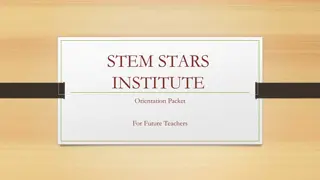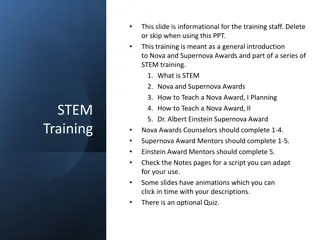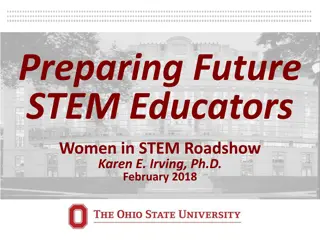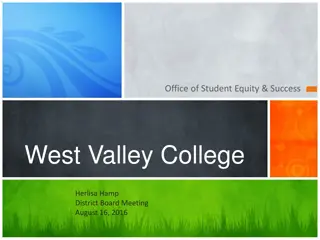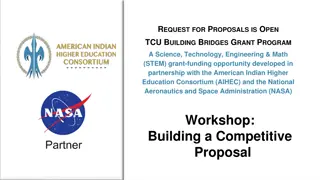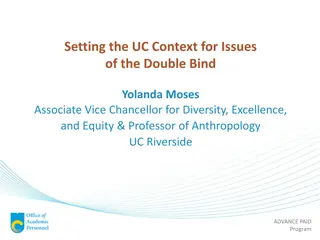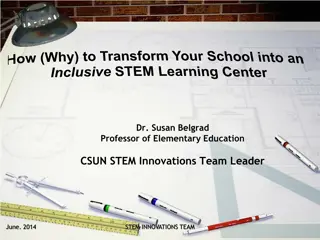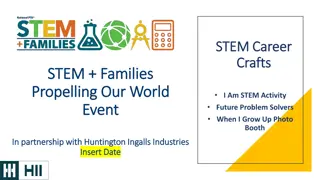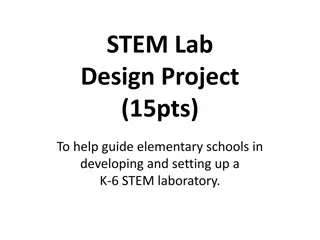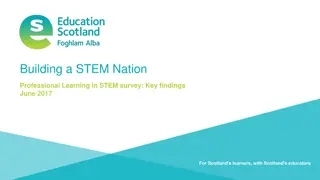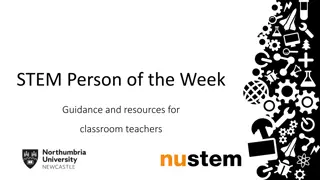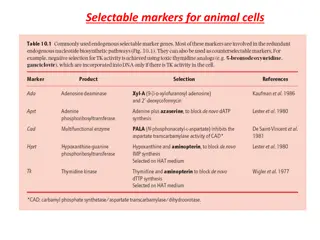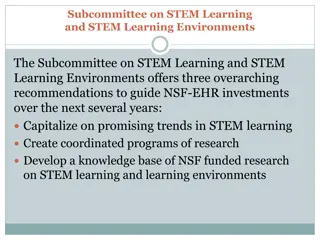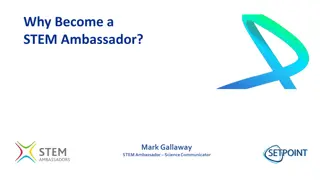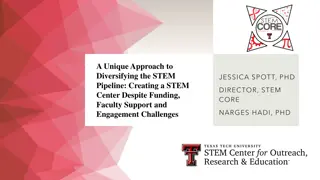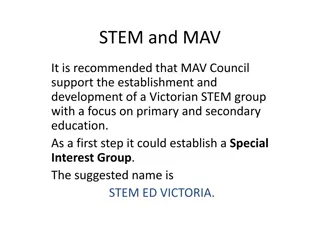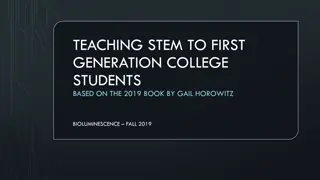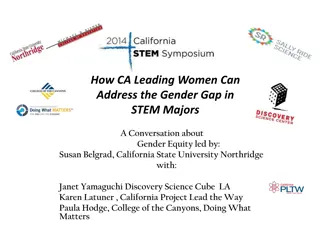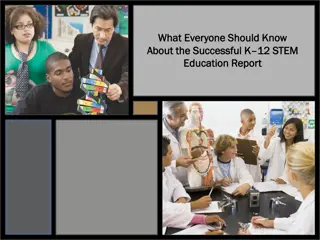Promoting Equity and Success in STEM: Addressing Second-Year Challenges in College
Promoting Equity and Success in STEM focuses on addressing second-year challenges in college for students interested in the sciences. The program implemented at Grinnell and Carleton College includes a pre-orientation program, curricular changes, early research exposure, and a supportive community. Evidence of success includes increased diversity in STEM fields, improved academic performance, and greater involvement in student leadership. However, challenges persist in 200-level science and math courses, particularly for first-generation and students of color. National research highlights the "sophomore slump," emphasizing the need to redefine this period as a unique phase with specific issues and opportunities.
Uploaded on Sep 28, 2024 | 4 Views
Download Presentation

Please find below an Image/Link to download the presentation.
The content on the website is provided AS IS for your information and personal use only. It may not be sold, licensed, or shared on other websites without obtaining consent from the author.If you encounter any issues during the download, it is possible that the publisher has removed the file from their server.
You are allowed to download the files provided on this website for personal or commercial use, subject to the condition that they are used lawfully. All files are the property of their respective owners.
The content on the website is provided AS IS for your information and personal use only. It may not be sold, licensed, or shared on other websites without obtaining consent from the author.
E N D
Presentation Transcript
Promoting Equity and Success in STEM: Addressing the Second Year Grinnell College: Jim Swartz, Dack Professor of Chemistry Leslie Gregg-Jolly, Project Director Joyce Stern, Student Success & Academic Advising Carleton College: Ellen Iverson, Science Education Resource Center
Institutional Context: What Is GSP? A pre-orientation program for students interested in the sciences Curricular change in the sciences new kinds of pedagogy Early exposure to research in and out of class A community of students, faculty, and student life staff
Evidence of SuccessStatistical Increased number of students of color Dramatic increases in areas with most severe underrepresentation (Phys, CS, Math) Improved Science GPA for target group Significant increase in participation in student life leadership by students of color
but in 200-level Science and Math Classes 1stgeneration and students of color demonstrated less success in 200-level biology and chemistry courses In other 200-level science and math courses success rates for all groups of students were similar to each other
National Research on 2nd-yr Students Sophomore slump (Freedman, 1956) Developmental Factors in the Second Year: Second year is a time of development confusion (Lemons & Richmond, 1987; Schaller, 2005) Sophomores are between in every aspect (Boivin, Fountain, & Baylis, 2000); the middle child (Gahagan & Hunter, 2006) Institutional/Environmental Factors: Services provided for first-years are no longer available Need assistance but find little outreach (Kramer, 2000) Redefine the slump not characterize it as a pathology, but as a unique set of issues, circumstances, changes, challenges, and opportunities in the second year
(Gansemer-Topf, A. M., Stern, J. & Benjamin, M. 2007) Findings from Grinnell Study of Sophomores Academic Life - Increased demands/ challenge - Major declaration - OCS - Big decisions Purpose - Elevated/changing expectations - Leadership - Time demands - Friendships disperse - Relationships deepen/ change - Meet new people Extracurricular Activities Social Relationships
Citations Boivin, M., Fountain, G.A., & Baylis, B. (2000). Meeting the challenge of the sophomore year. In J. Pattengale & L. A. Schreiner (Eds.).Visible solutions for invisible students: Helping sophomores succeed (pp. 1-18). (National Resource Center for the Freshmen Year Experience and Students in Transition Monograph No. 31). Columbia, SC: University of South Carolina. Freedman, M. B. (1956). The passage through college. Journal of Social Issues, 12, 13-27. Gahagan, J. & Hunter, M.S. (2006). The second-year experience: Turning attention to the academy s middle child. About Campus, 11(3), 17-22. Gansemer-Topf, A. M., Stern, J., & Benjamin, M. (2007). Examining the Experiences of Second-Year Students at a Private Liberal Arts College. In B. F. Tobolowsky and B. E. Cox (Eds.) Shedding light on sophomores: An exploration of the second college year (Monograph No. 47, pp. 31-48). Columbia, SC: University of South Carolina, National Resource Center for the First-Year Experience and Students in Transition. Kramer, G. L. (2000). Advising students at different educational levels. In V. N. Gordon, W. R. Habley, & Associates (Eds.) Academic Advising: A Comprehensive Handbook (pp. 84 104). San Francisco: Jossey-Bass. Lemons, L. J. & Richmond, D. R. (1987). A developmental perspective of sophomore slump. NASPA Journal, 24(3), 15-19. Schaller, M. A. (2005). Wandering and wondering: Traversing the uneven terrain of the second college year. About Campus, 10(3), 17-24.
Project Focusing on the 2nd Year* Focused on intermediate-level students Builds on our widespread reform of all introductory-level science classes and our mature advanced research program External and internal studies describe the challenges facing second-year students Multifaceted approach (like GSP) *supported in part by a grant to Grinnell College from the Howard Hughes Medical Institute (HHMI) through the Precollege and Undergraduate Science Education Program.
2nd year science student retreat Posters with survey data posted Quantitative survey Lessons from Grinnell Science Project Transcript analysis Follow up interviews In situ observations Focus groups Research including Gansemer-Topf, Stern, and Benjamin, 2007 Development of HHMI supported program focused on second year science students 2013-2014 August January May
Quantitative Survey How much fun is math or science for you? How likely are you to do math or science problems that are not assigned? How likely are you to read about math or science in your spare time? How likely are you to talk about math or science outside of work you need to do for class? I feel comfortable in approaching faculty members when I need help.
Acknowledgment Survey Questions From Lopatto, D. Classroom Undergraduate Research Experience (CURE) Survey developed from a creative collaboration of faculty from Grinnell College, Hope College, Harvey Mudd College, and Wellesley College, funded by HHMI. Renninger, K. A., & Schofield, L. S. (April, 2012). Measuring interest: The open-ended response in a large scale survey. Paper presented as part of the symposium, The latest in interest measurement: New approaches and new insights, at the Meetings of the American Educational Research Association, Vancouver, BC, Canada. Gross, Iverson, Willett, & Manduca (accepted). Broadening access to science with support for the whole student in a residential liberal arts college environment. Journal of College Science Teaching.
Survey Use Inform the College about the lived experiences of our students Posters displayed at 2nd year science retreat and posted around science building Inform focus groups and interviews to better understand the local issues
To what extent do you consider yourself a mathematician or scientist? Scale:1 = Not at all 5 = Very Avg 3.7 StDev 1.00 What is your image of a scientist? What skills do you possess that make you like a scientist? What value is there in having people who see things in different ways working on the same scientific problem?
Ave: 5.3 StDev 1.52 1=Low 7=High 1=Low 7=High Is starting to work in a new group hard for you? It is challenging for most people. Look for ideas today to help you feel more comfortable with this process.
Second Year Retreat Help students identify and meet challenges faced by second-year science students Navigate curriculum Manage workload Prepare for research Explore majors and career options One day, facilitated by faculty, staff, upper-level students, and alumni Community building
Second Year Retreat Survey 97% would encourage others to attend 90% helped them feel better prepared for academic challenges ~90% enhanced their sense of belonging in the sciences ~95% helped them better understand opportunities and resources Informal time with faculty was highly valued
Focus Groups and Interviews 8 focus groups in February 47 second year students 14 third/fourth year students 14 phone interviews in May 11 non-focus group 3 focus group participants
Results - Barriers Liberal arts experience as science major Courses viewed as weeders Multi-cultural mentors, not as available Range of 1st year skills I didn t come in with any AP credits. And then I didn t have a lot of focus, like I wasn t sure what I was doing when I first got here. I have to work on time management and have to develop more relationships. Everything together creates a lot of pressure. . . .organic chemistry. I mean, I hated it. . . But the fact that I like survived it and actually could do well on it sort of like gave me the confidence to still continue to be a science major
Results Key Supports Peer mentors Approachable faculty Specific courses Sophomore retreat I've had really good experiences talking to computer science faculty, because they're so available. Like there's talks every Thursday about various computer science topics, and they're there. And before the talks, we all hang out, and they like provide cookies and stuff. And on Fridays, we all eat lunch together and discuss articles. . . .mentor sessions just provide a more laidback atmosphere to talk about your classes and how you can do well in them. . .it s also a really good bonding experience. It helps to formulate community within the sciences.
Results Emerging Supports Noyce Science Center I think Noyce is extremely excellent for supporting collaboration and openness, because there s just like tables, and you just like walk by, and you see someone at a table, and you chat about the homework. So I think the communal spaces here really do a lot to help that. I can just go to the computer science lounge and see other people and chill with them. Having more spaces where people can have that interaction that tends to make people feel like they belong. Informal science social events A bio and chem professor host lunch in the dining hall, and students can just come and talk to them about anything. . . I thought it was a nice way to get to know your professors or people that you wouldn't otherwise come in contact with
Results - Group work 1st year challenges but essential by 3rd and 4th year . . . It's an issue with people who just are unable to, they're just not able to produce as quality work in a specific scenario.. . . .the further I've gotten into the coursework for certain majors, it seems group work is a lot easier to, you know, really do well and enjoy, because most of the students kind of share your aptitude and enjoy the course work. It's [group work] also important because if you go into a career in the sciences, you're going to like collaborate on papers and things Promotes community when done well I really enjoy the sense of community that we have, especially within the second year science students and we have formed a family where we work together through our problems [in group work].
So what? Value of making the obvious explicit Cheap and easy efforts can have a big impact: Survey & Posters Mythbuster posters One day retreat Comprehensive change in how we do business: Harder to implement and assess, but possible Hopefully long lasting impact
Acknowledgments Faculty, staff and students from Grinnell College Howard Hughes Medical Institute Precollege and Undergraduate Science Education Capstone Award 2012 to Grinnell College Science Education Resource Center at Carleton College


